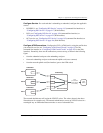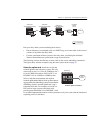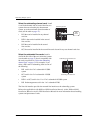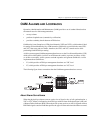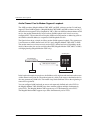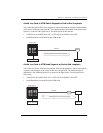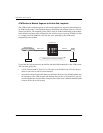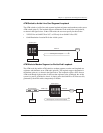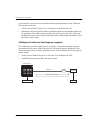
Chapter 3: Applications and Configuration Overview
Avidia System Configuration and Management User Manual 59
OAM Location ID
OAM segment and end-to-end tests rely on OAM Location ID addresses to designate a
source that originates the loopback test and a destination that is the target loopback device.
The OAM Source Location ID address for Avidia systems is a unique sixteen-octet address
and is entered in the format xx:xx:xx:xx:xx:xx:xx:
xx:xx:xx:xx:xx:xx:xx:xx:xx, where x is an
integer 0 through 9 or an alpha character a through f. The Source Location ID default is
ff:ff:ff:ff:ff:ff:ff:ff:ff:ff:ff:ff:ff:ff:ff:ff. Set the OAM Source Location ID address for an Avidia
system through either the command-line interface or through the Web interface. It is
recommended that the OAM Source Location ID address for the Avidia system is set up with:
• a unique address that is meaningful to you for the first 13 octets (for example, you could
use the prefix of the system ATM network address)
• all zeros for the last three octets
Similarly, other non-Avidia ATM devices in the network (for example, ATM switches)
must have a unique OAM Location ID address to run OAM tests. This address is typically
forwarded from the network service access point (NSAP) for the node.
The Megabit Modem, however, does not require an OAM Location ID address to be a
destination for either a segment or end-to-end test. When a Megabit Modem is the
destination, simply do not set a value in the OAM Destination Location ID address field.
The Location ID address and the ATM address are different and unique addresses for
identifying each ATM device in an ATM network. See “ATM Device Addresses” on page 23
for more information about ATM addresses and Location IDs.
Preparing to Run OAM Loopbacks
Do the following two sections before you run loopback tests.
Verify PVCs
Before running an OAM test, it is important to verify that an operational PVC (VPC for an
F4 loopback or VCC for an F5 loopback) is defined for every connection in the ATM network
where the test runs. For example, in the simple case where you run an OAM segment loopback
between an Avidia system and a Megabit modem, define a PVC for the Megabit Modem that
corresponds to a PVC on the channel card port in the Avidia system to which the modem
is connected.
In more complex OAM loopbacks, where an OAM segment or end-to-end loopback is run
across multiple Avidia systems or ATM switches, a PVC must be defined within each ATM
node in the test path.



